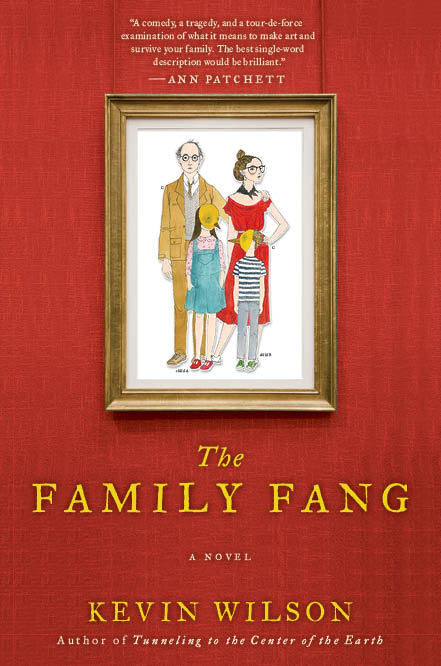The Family Fang was an almost universal choice on every "best" list in 2011. Now in paperback, it has been added to the BPL Book Discussion 2013 schedule. I am actually excited to read it again. But on to my report on who would like this book and why.
The Family Fang has a pretty easy to articulate set-up. Our narrators are Annie and Buster. In the present of the story, they are both screwed up young adults (not teens, actual adults, but in their 20s) who had both found moderate success as an actress (Annie) and a writer (Buster), but as the story opens, both have reached crisis points in their lives and the possible end to their careers. Why are they falling apart? Well as children they were the famous sidekicks (Child A and Child B) to their performance artist parents Camille and Caleb Fang who reached international success and critical acclaim as performance artists who, in the 1980s, became famous for going to public spaces and causing chaos. As you can imagine, this explains why Annie and Buster are a bit messed up now.
When Annie and Buster are both forced to return home to their parents, the drama and chaos return to their lives. After a short time at home, Camille and Caleb disappear and are presumed dead, but Annie and Buster are suspicious that it is all a new performance piece. Together, Annie and Buster investigate their parents disappearance and along the way confront their own troubled pasts.
Not only do Annie and Buster alternate telling the story of "now," but in between their chapters are separate chapters which describe the performance pieces of Caleb and Camille. These performance piece chapters all happened in the past when the kids were small and begin with a clear heading such as this one from the very first chapter:
So we have multiple points of view and a shifting time frame here. I thought Wilson did a great job of weaving the story together so that these shifts seemed inevitable. As a reader you got just the right description of one of the Fang performance art pieces at just the right time in the story. They were never intrusive or disruptive; in fact, they were often quite enlightening. I looked forward to them because they helped to shed light on the "now" part of the narrative.[crime and punishment, 1985artists: caleb and camille fang]
Which leads to the point of view changes. These two are important to the enjoyment of the story. Annie and Buster have two different perspectives and reactions to their childhoods. Seeing them each deal with their parent's disappearance helps to create the full picture of all four family members as characters.
Ahh, characters. This is a good time to mention that while the novel has a solid investigative plot as Buster and Annie try to figure out what happened to their parents, the story ends resolved but open. This is not a book for plot driven readers; it is one for lovers of the character centered story. This is a story about Camille and Caleb to a point, but when it is all said and done, it is a coming of age story for Annie and Buster (a delayed coming of age, but a coming of age nonetheless). Everything that happens in the novel is leading toward a moment of epiphany for Annie and Buster. By the end of the story, each has been able to come to terms with their crazy and unhealthy childhood (for the first time in their lives) and move forward as an adult. We hope that things will work out for them, and the ending hints that it will, but we do not know for sure.
Similarly, we know "what happened" to Caleb and Camille by the novel's end, but their story has another chapter, yet to be written. We will never know if what they want to happen, will actually come to fruition. Also, although we have learned a lot more about Caleb and Camille by the end, they are still a bit of an enigma. I think this works though because it is really Annie and Buster's story and the Camille and Caleb storyline is tied up enough. But again, those who want a clean ending will not get one here. Me, I prefer my endings to be this way.
Many people will enjoy the satirical look at performance art. In fact, the entire novel has a satirical tone that moves it into a caper feel. It is thought provoking with the satire, but it is also so outrageous at times that it is hysterical. Specifically the way others in the art community talk about the Fangs is so ludicrous it is funny.
Three Words That Describe This Book: character centered, open ending, shifting time frame
Readalikes: When I was thinking of books with a similar satirical tone, family dysfunction, and character centered story line three books I have read in the last couple of years came to mind immediately. This got me thinking that this is a type of book I generally enjoy. Interestingly, none of them make my best of the year lists either. These are books I like a lot, but don't love. Hmmm, thank you The Family Fang for helping me to discover this new dimension to by own reader profile.
Enough soul searching, here they are with the links to my reviews for more detail:
- Where'd You Go Bernadette by Maria Semple
- The Radleys by Matt Haig
- Solar by Ian McEwan
- The Dissident by Neil Freudenburger in which a Chinese performance artist comes to Beverly Hills and gets entangled in some family issues.
- Clear: A Transparent Novel by Nicola Barker which is centered around the time the magician David Blaine suspended himself over the Thames in a clear box.

No comments:
Post a Comment